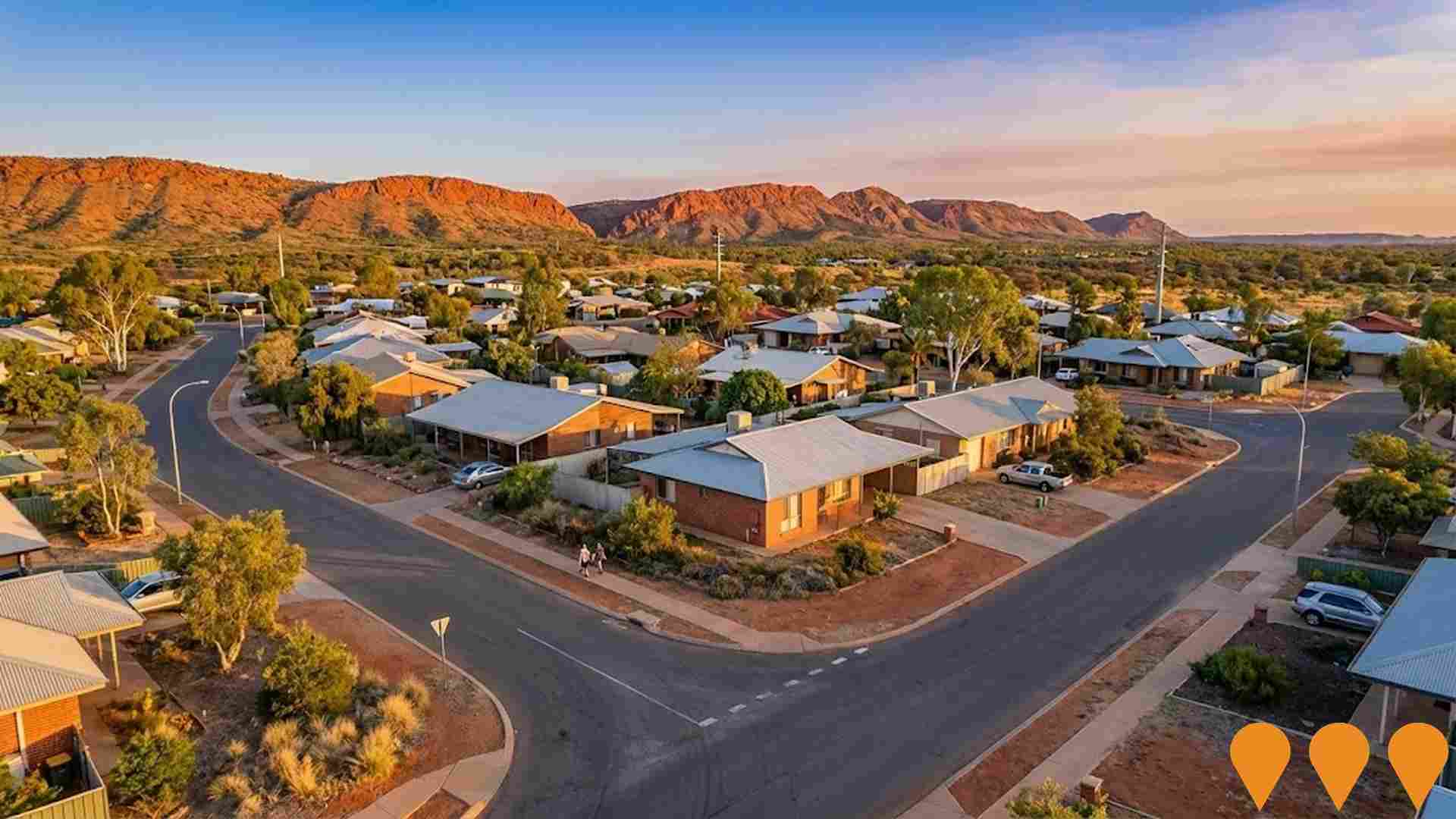Chart Color Schemes
est. as @ -- *
ABS ERP | -- people | --
2021 Census | -- people
Sales Activity
Curious about local property values? Filter the chart to assess the volume and appreciation (including resales) trends and regional comparisons, or scroll to the map below view this information at an individual property level.
Find a Recent Sale
Sales Detail
Population
Ross lies within the top quartile of areas nationally for population growth performance according to AreaSearch analysis of recent, and medium to long-term trends
Ross's population was around 3,099 as of August 2025. This reflected an increase of 393 people (14.5%) since the 2021 Census, which reported a population of 2,706 people. The change was inferred from the estimated resident population of 3,094 in June 2024 and an additional 10 validated new addresses since the Census date. This level of population resulted in a density ratio of 16.3 persons per square kilometer. Ross's 14.5% growth since the 2021 census exceeded the national average (8.6%) and the state average, marking it as a growth leader in the region. Population growth was primarily driven by interstate migration, contributing approximately 73.7% of overall population gains during recent periods.
AreaSearch adopted ABS/Geoscience Australia projections for each SA2 area, released in 2024 with a base year of 2022. For areas not covered by this data and to estimate growth post-2032, AreaSearch applied growth rates by age cohort to each area, as provided by the ABS in its latest Greater Capital Region projections (released in 2023, based on 2022 data). Future population trends projected an above median growth for Australian non-metropolitan areas. The area was expected to increase by 621 persons to 2041, with a total increase of 19.9% over the 17 years.
Frequently Asked Questions - Population
Development
AreaSearch analysis of residential development drivers sees Ross recording a relatively average level of approval activity when compared to local markets analysed countrywide
Ross has received approximately 17 dwelling approvals annually over the past five financial years, totalling 86 homes. In FY26 so far, there have been 5 recorded approvals. On average, 3.3 new residents arrive per year for each dwelling constructed between FY21 and FY25. This supply lag indicates heightened buyer competition and pricing pressures, with new dwellings averaging $399,000, below regional levels.
In FY26, $12.5 million in commercial development approvals have been recorded. Ross records 245.0% more building activity per person compared to the Rest of NT. Recent construction comprises 50.0% detached houses and 50.0% townhouses or apartments, reflecting a shift from the area's existing housing composition of 73.0% houses. The estimated population density is 342 people per dwelling approval. Population forecasts indicate Ross will gain 616 residents by 2041. With current construction levels, housing supply should meet demand adequately, creating favourable conditions for buyers and potentially enabling growth exceeding current forecasts.
Population forecasts indicate Ross will gain 616 residents through to 2041. With current construction levels, housing supply should adequately meet demand, creating favourable conditions for buyers while potentially enabling growth that exceeds current forecasts.
Frequently Asked Questions - Development
Infrastructure
Ross has limited levels of nearby infrastructure activity, ranking in the 4thth percentile nationally
Changes to local infrastructure significantly influence an area's performance. AreaSearch has identified eleven projects likely impacting the region. Notable initiatives include Kilgariff Estate, St Mary's Land Development, Heavitree Gap Road Duplication Planning Study, and Alice Springs Future Grid - Roadmap to 2030. The following list details projects most relevant to the area.
Professional plan users can use the search below to filter and access additional projects.
INFRASTRUCTURE SEARCH
 Denotes AI-based impression for illustrative purposes only, not to be taken as definitive under any circumstances. Please follow links and conduct other investigations from the project's source for actual imagery. Developers and project owners wishing us to use original imagery please Contact Us and we will do so.
Denotes AI-based impression for illustrative purposes only, not to be taken as definitive under any circumstances. Please follow links and conduct other investigations from the project's source for actual imagery. Developers and project owners wishing us to use original imagery please Contact Us and we will do so.
Frequently Asked Questions - Infrastructure
Alice Springs Hospital Emergency Department Redevelopment
Major redevelopment and expansion of the Alice Springs Hospital Emergency Department to deliver a larger, modern facility with increased treatment spaces, dedicated paediatric area, fast-track zone, and improved resuscitation capabilities for Central Australia's primary acute care hospital.

Better and Safer Future for Central Australia
AUD 250 million Australian Government program delivering new and upgraded housing (approximately 77 new dwellings), Remote Training Hubs, community infrastructure upgrades, and family safety initiatives across multiple remote Central Australia communities.
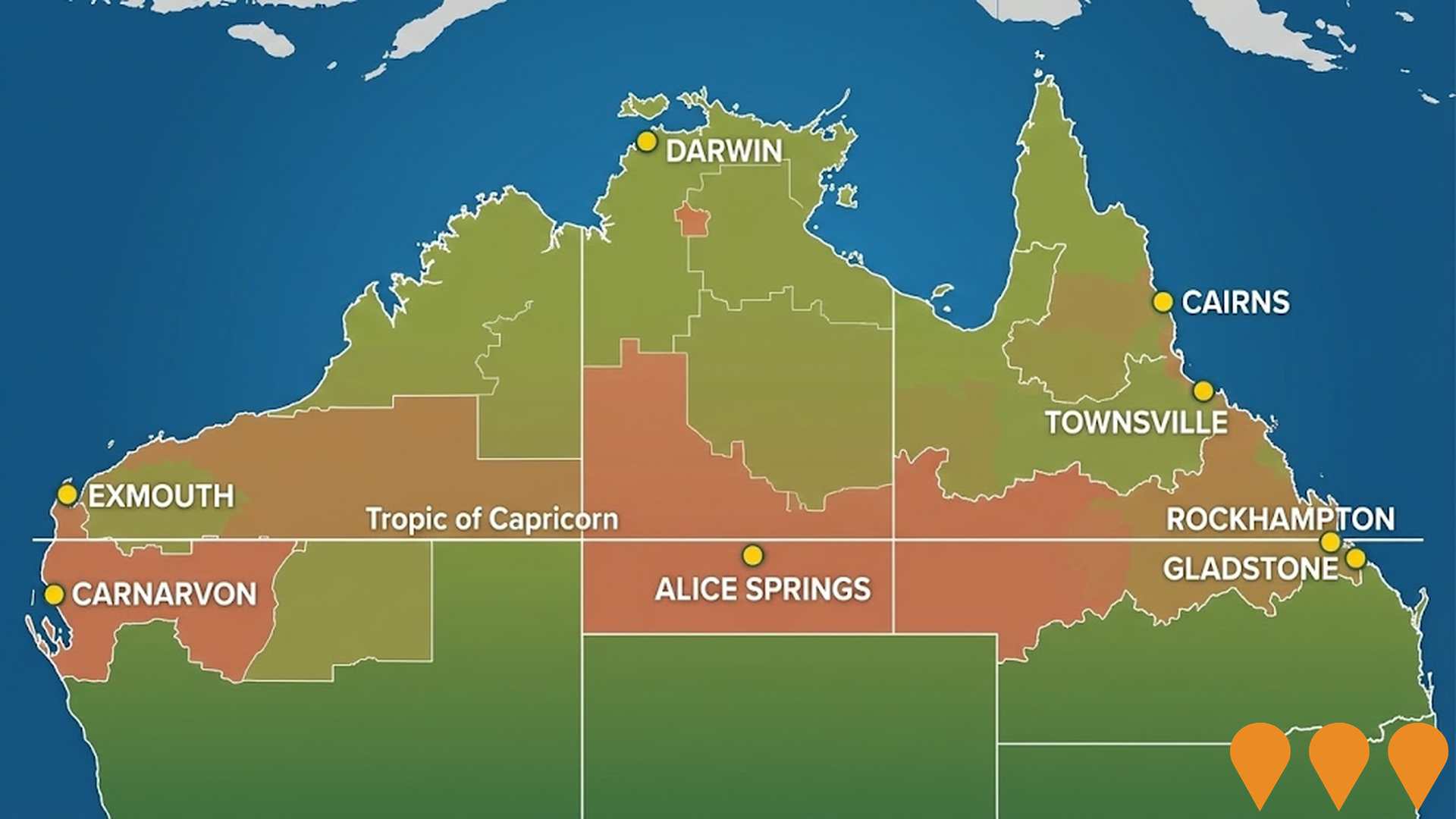
Alice Springs Future Grid - Roadmap to 2030
Three year whole of system initiative led by the Intyalheme Centre for Future Energy (a Desert Knowledge Australia project) to identify and remove barriers to achieving 50% renewable generation in Alice Springs by 2030. Concluded in 2024 with the Roadmap to 2030 and a suite of final reports after trials including a virtual power plant, an islandable microgrid at the Desert Knowledge Precinct, public housing solar and battery trial, and wind resource monitoring.
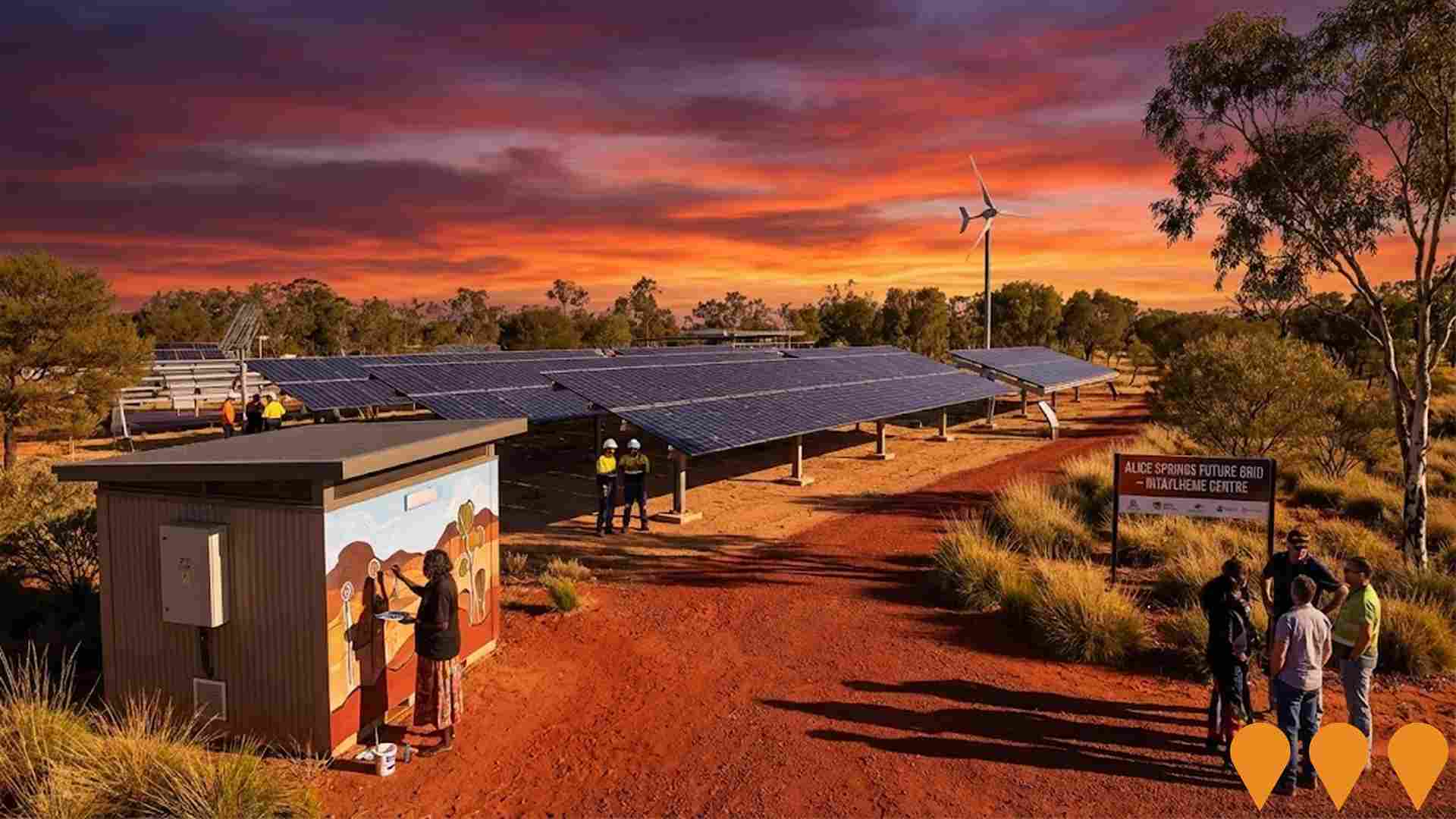
Enabling Digital Health Services for Regional and Remote Australia
National initiative to expand and improve digital health access for people in regional and remote Australia. Focus areas include enabling telehealth and virtual care, upgrading clinical systems and connectivity, supporting secure information exchange, and building workforce capability in digital health, aligned with the Australian Government's Digital Health Blueprint and Action Plan 2023-2033.
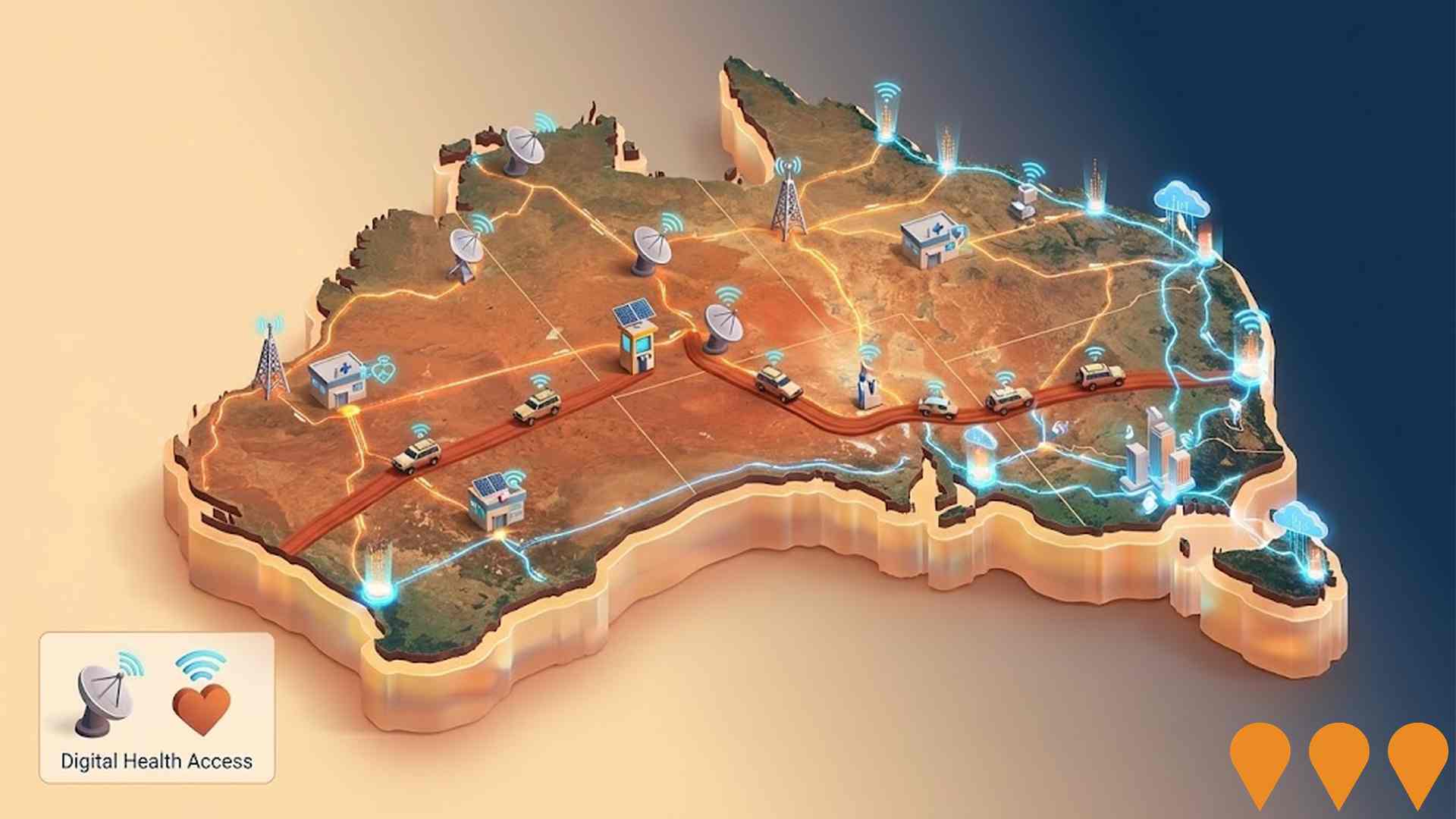
Alice Springs Flood Mitigation Project
Major flood mitigation infrastructure project to reduce flooding impacts in Alice Springs through trunk drainage upgrades. Engineering feasibility assessment underway to inform concept design of key trunk drainage infrastructure to mitigate flooding from the Todd River and localized stormwater overflows. The project focuses on structural flood mitigation measures including upgrades to major drainage infrastructure and is expected to reduce flooding impacts on 386 properties, providing flood immunity for public roads and improved protection for residential areas in localised flooding events up to a 1 in 100 year event.

St Mary's Hostel Social and Affordable Housing Project
Redevelopment of the historic 8.2-hectare St Mary's Hostel site to deliver up to 120 social and affordable dwellings. The project, backed by $14 million in Australian Government funding for enabling infrastructure and site works, will honor the site's historical, cultural, and heritage significance through the preservation of the St Mary's Chapel and its heritage-listed mural, and community access for events. The site was acquired by the Northern Territory Government in early 2024 for $3.25 million, but there are no immediate plans for full redevelopment, with initial efforts focused on preservation, land studies, and consultation with the St Mary's Stolen Generation Group.
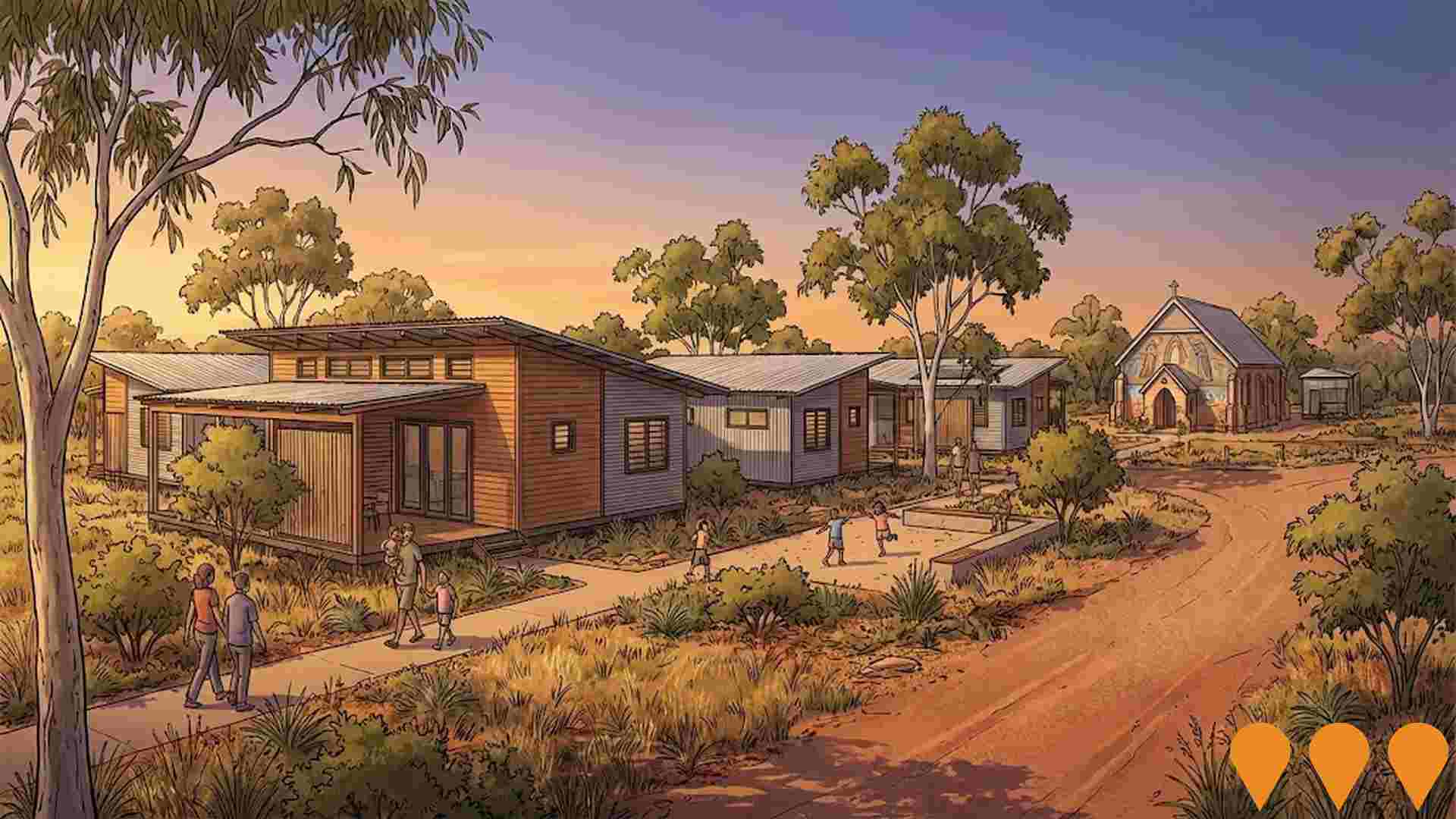
Kilgariff Estate
Kilgariff Estate is Alice Springs' newest master-planned residential suburb and greenfield development by the Land Development Corporation. The project is progressively releasing residential lots with diverse housing options, future amenities including schools, shops, parks, recreation facilities and cycle paths. Stage 1 (80 lots) is complete and sold out. Stage 2 civil works (including 2B) reached practical completion in 2024 with titles issuing progressively through 2025. The estate is located south of Alice Springs with views of the MacDonnell Ranges. Ongoing government investment supports further headworks and subdivision for additional residential land release to meet population growth.
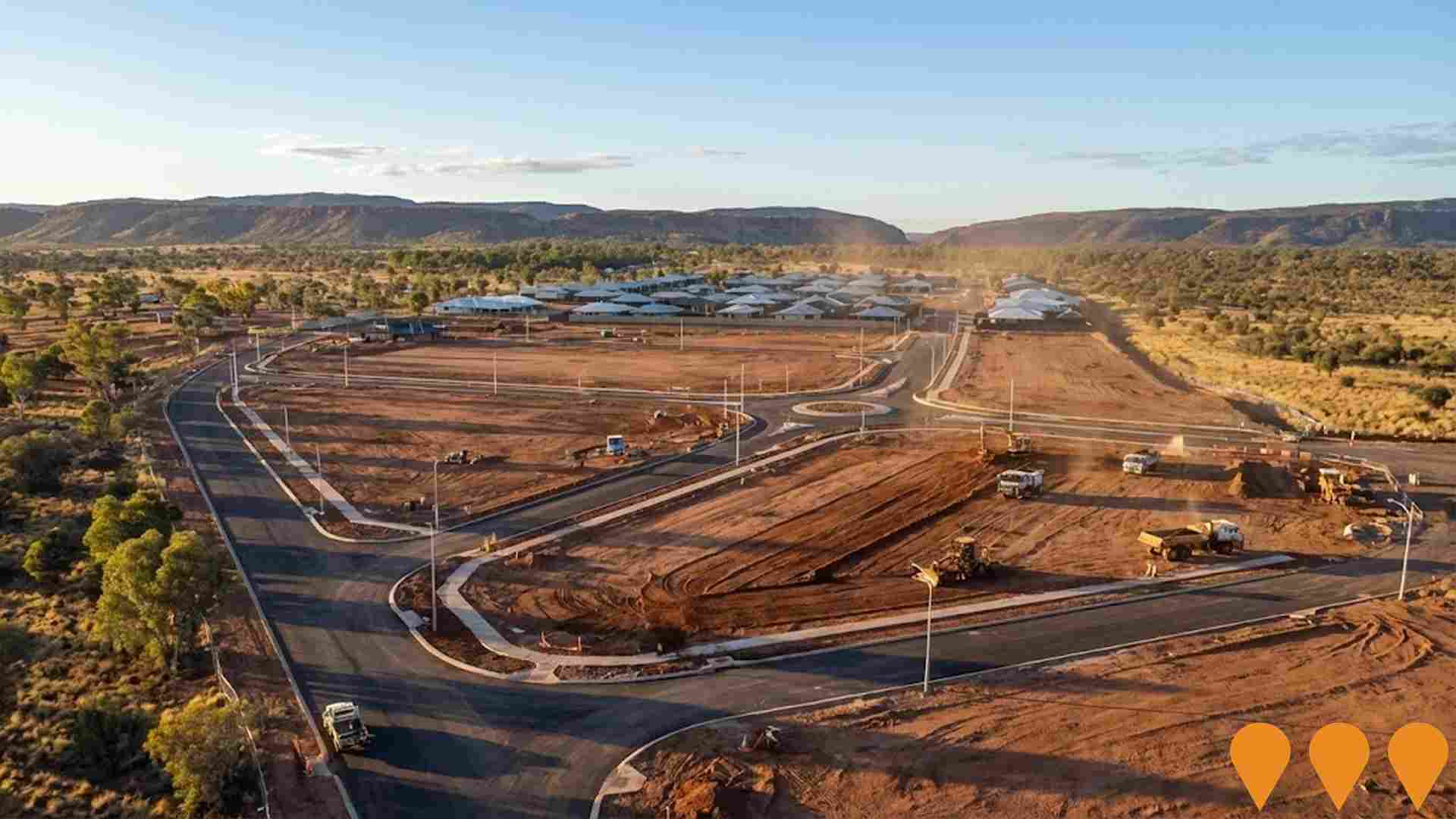
St Mary's Land Development
The NT Government acquired the historic 8.2-hectare St Mary's site in March 2024 for $3.25 million to develop up to 120 social and affordable housing dwellings. The Australian Government has committed $14 million for enabling infrastructure including power, water, sewerage, roads, site preparation, demolition and remediation. The development will preserve the heritage-listed St Mary's Chapel with its 1958 Robert Czako mural and other sites of cultural significance important to the Stolen Generations. The site, located on the Stuart Highway alongside the Todd River south of Heavitree Gap, operated as a boarding school for mainly Aboriginal children from 1947 to 1972. While there are no immediate plans for construction, the project is part of the Housing Australia Future Fund and National Infrastructure Facility programs, with the NT Government working closely with the St Mary's Stolen Generation Group to ensure development honors the legacy of former residents.
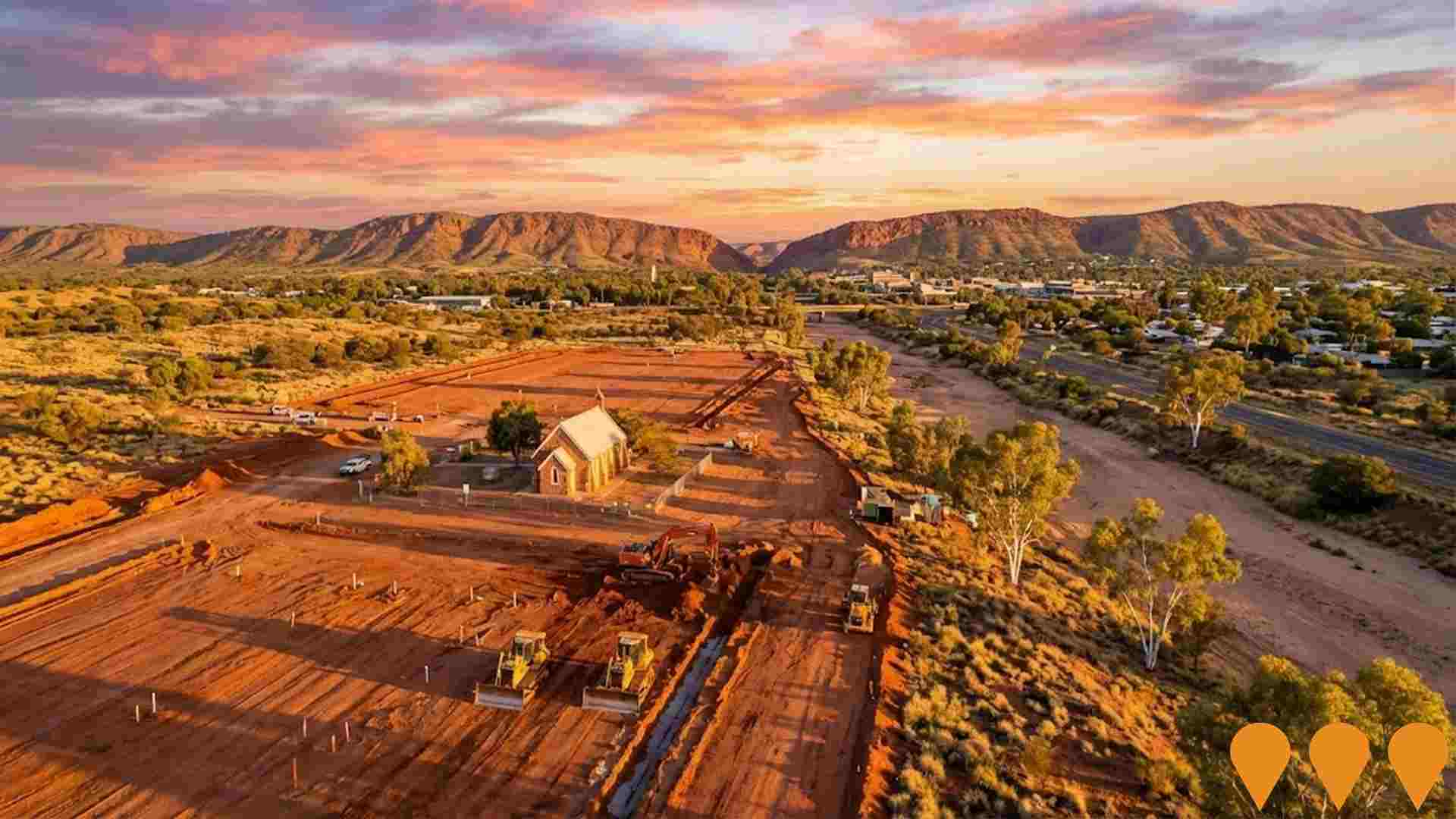
Employment
Employment conditions in Ross demonstrate strong performance, ranking among the top 35% of areas assessed nationally
Ross has a skilled workforce with essential services sectors well represented. The unemployment rate in Ross is 1.9% as of June 2025.
There are 2,018 residents employed, and the unemployment rate is 3.9% lower than the Rest of NT's rate of 5.9%. Workforce participation in Ross is 56.1%, compared to the Rest of NT's 50.7%. Employment among residents is concentrated in health care & social assistance, public administration & safety, and construction. Construction has a particularly strong presence with an employment share 1.8 times the regional level.
Agriculture, forestry & fishing has limited presence with 1.1% employment compared to the regional 5.0%. The area may offer limited local employment opportunities, as indicated by the count of Census working population vs resident population. Between June 2024 and June 2025, Ross's labour force decreased by 1.8%, while employment declined by 1.5%, resulting in a fall in unemployment rate by 0.3 percentage points. In comparison, the Rest of NT recorded an employment decline of 1.7% and a labour force decline of 1.8%, with a marginal decrease in unemployment. Jobs and Skills Australia's national employment forecasts from May 2025 suggest potential future demand within Ross. These projections estimate national employment growth at 6.6% over five years and 13.7% over ten years, with varying rates across industry sectors. Applying these projections to Ross's employment mix suggests local growth of approximately 6.6%% over five years and 13.6% over ten years.
Frequently Asked Questions - Employment
Income
Income metrics indicate excellent economic conditions, with the area achieving higher performance than 75% of national locations assessed by AreaSearch
According to AreaSearch's aggregation of the latest postcode level ATO data released on June 30, 2022, Ross had a median income among taxpayers of $61,801 with the average level standing at $71,223. This is above the national average and compares to levels of $51,655 and $61,577 across Rest of NT respectively. Based on Wage Price Index growth of 12.01% since financial year 2022, current estimates would be approximately $69,223 (median) and $79,777 (average) as of September 2025. From the 2021 Census, household, family and personal incomes in Ross cluster around the 68th percentile nationally. The earnings profile shows the $1,500 - 2,999 bracket dominates with 30.9% of residents (957 people), aligning with regional levels where this cohort likewise represents 33.6%. After housing costs, residents retain 94.7% of income. The area's SEIFA income ranking places it in the 5th decile.
Frequently Asked Questions - Income
Housing
Ross is characterized by a predominantly suburban housing profile, with above-average rates of outright home ownership
In Ross, as per the latest Census evaluation, 73.2% of dwellings were houses with the remaining 26.8% being other types such as semi-detached homes and apartments. This is in contrast to Non-Metro NT's figures of 67.8% houses and 32.2% other dwellings. Home ownership in Ross stood at 26.8%, with mortgaged properties at 35.9% and rented ones at 37.3%. The median monthly mortgage repayment was $0, significantly lower than Non-Metro NT's average of $1,800 and the national figure of $1,863. The median weekly rent in Ross was $280, which is also lower than Non-Metro NT's $280 and the national average of $375.
Frequently Asked Questions - Housing
Household Composition
Ross has a typical household mix, with a lower-than-average median household size
Family households constitute 68.5% of all households, including 28.5% couples with children, 27.3% couples without children, and 11.5% single parent families. Non-family households account for the remaining 31.5%, with lone person households at 28.9% and group households comprising 3.1%. The median household size is 2.5 people, which is smaller than the Rest of NT average of 2.8.
Frequently Asked Questions - Households
Local Schools & Education
Ross faces educational challenges, with performance metrics placing it in the bottom quartile of areas assessed nationally
The area's educational profile is notable regionally, with university qualification rates at 25.6% of residents aged 15+, surpassing the SA4 region average of 20.1% and that of Rest of NT (20.1%). Bachelor degrees are most prevalent at 16.8%, followed by postgraduate qualifications at 5.6% and graduate diplomas at 3.2%. Vocational credentials are also prominent, with 35.2% of residents aged 15+ holding such qualifications – advanced diplomas at 7.9% and certificates at 27.3%.
Educational participation is high, with 31.6% of residents currently enrolled in formal education. This includes 11.5% in primary education, 8.2% in secondary education, and 4.9% pursuing tertiary education. The area's educational provision includes Yirara College and Alice Springs Steiner School, collectively serving 322 students. Educational conditions vary across Ross, with the educational mix including one secondary school and one K-12 school. School places per 100 residents stand at 10.4, below the regional average of 15.0, indicating some students may attend schools in adjacent areas.
Frequently Asked Questions - Education
Schools Detail
Nearby Services & Amenities
Transport
Transport servicing is very low compared to other areas nationally based on assessment of service frequency, route connectivity and accessibility
Ross has 11 active public transport stops, all of which are bus stops. These stops are served by two routes that combined offer 54 weekly passenger trips. Transport accessibility is limited, with residents typically located 2439 meters from the nearest stop.
On average, there are 7 trips per day across all routes, equating to approximately 4 weekly trips per individual stop.
Frequently Asked Questions - Transport
Transport Stops Detail
Health
Health outcomes in Ross are marginally below the national average with the level of common health conditions among the general population somewhat typical, though higher than the nation's average among older cohorts
Health indicators suggest below-average outcomes in Ross compared to national averages.
Common health conditions are somewhat typical among the general population but higher than average among older cohorts. Private health cover is very high at approximately 55% of the total population (1,704 people). The most common medical conditions are arthritis and diabetes, impacting 6.4% and 6.3% of residents respectively. 71.5% of residents declare themselves completely clear of medical ailments compared to 76.9% in Rest of NT. Ross has a higher proportion of residents aged 65 and over at 18.3% (566 people) compared to the Rest of NT's 9.3%. Health outcomes among seniors require more attention than those of the broader population.
Frequently Asked Questions - Health
Cultural Diversity
The level of cultural diversity witnessed in Ross was found to be above average when compared nationally for a number of language and cultural background related metrics
Ross had a cultural diversity index above average, with 18.6% of its population born overseas and 23.6% speaking a language other than English at home. Christianity was the predominant religion in Ross, comprising 51.1% of the population. However, Judaism was notably overrepresented in Ross, making up 0.3% of the population compared to 0.1% across Rest of NT.
In terms of ancestry, Australian was the top represented group in Ross at 25.1%, substantially higher than the regional average of 17.0%. English also had a high representation at 24.1%, surpassing the regional average of 17.4%. However, Australian Aboriginal had a notably lower representation in Ross at 16.5% compared to the regional average of 28.9%. Additionally, there were notable divergences in the representation of certain ethnic groups: German was overrepresented at 4.3% (vs 3.3% regionally), Filipino at 1.4% (vs 1.7%), and New Zealand at 0.7% (vs 0.6%).
Frequently Asked Questions - Diversity
Age
Ross hosts an older demographic, ranking in the top quartile nationwide
Ross has a median age of 42, which is considerably higher than the Rest of NT average of 31 and substantially exceeds the Australian median of 38. Compared to the Rest of NT, Ross has a higher concentration of 65-74 year-olds at 10.8%, but fewer 25-34 year-olds at 14.2%. Between the 2021 Census and the present, the 15-24 age group has grown from 9.5% to 11.2% of Ross's population. Conversely, the 55-64 cohort has declined from 15.4% to 14.0%, and the 45-54 age group has dropped from 14.2% to 13.2%. Demographic modeling suggests that Ross's age profile will evolve significantly by 2041, with the 75-84 cohort projected to grow by 76%, adding 117 residents to reach 273.

